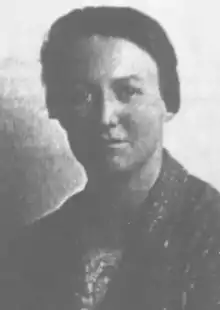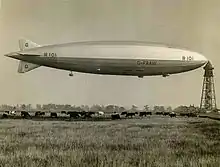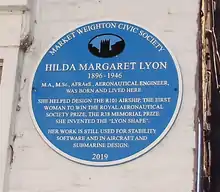Hilda Lyon
Hilda Lyon, AFRAeS (31 May 1896 – 2 December 1946) was a British engineer who invented the "Lyon Shape", a streamlined design used for airships and submarines.
Hilda Margaret Lyon | |
|---|---|
 | |
| Born | 31 May 1896 Market Weighton, Yorkshire, England |
| Died | 2 December 1946 (aged 50) Surrey, England |
| Nationality | British |
| Education | Newnham College, Cambridge |
| Engineering career | |
| Employer(s) | Siddeley-Deasy, George Parnall, Royal Airship Works |
| Projects | R101 |
| Significant design | "Lyon Shape" |
| Awards | R38 Memorial Prize |
Early life and education
Lyon was born in 1896 in Market Weighton, Yorkshire.[1] She was the youngest daughter of Thomas and Margaret Lyon (née Green); her father was a grocer.[2][3][4] Hilda Lyon attended Beverley High School and then in 1915 went to Newnham College, Cambridge, from which she obtained a MA in mathematics.[1][5]
Career in aviation
After graduating, Lyon took an Air Ministry course in aeroplane stress-analysis and then obtained a job as a technical assistant.[5] She saw no prospect of promotion or more responsibility "for a woman mathematician" in this job, so she and her sister quit their jobs and went to Switzerland for six weeks.[6]
In 1918, Lyon worked as an Aircraft Technical Assistant for Siddeley-Deasy. She moved to George Parnall & Co. in 1920.[5]

Around 1922, Lyon was admitted as an Associate Fellow of the Royal Aeronautical Society.[7] From 1925 onwards, she was a member of technical staff at the Royal Airship Works in Cardington, helping to develop the R101 rigid airship through her work on aerodynamics.[5]
In 1930, Lyon was awarded the R38 Memorial Prize by the Royal Aeronautical Society for her paper "The Strength of Transverse Frames of Rigid Airships".[8] It was the first time that any prize of the society had been won by a woman.[7]
Lyon's work involved travel to America, Canada, and Germany. In 1930 she went to America on a Mary Ewart Travelling Scholarship and took up studies at Massachusetts Institute of Technology, where she was first permitted to use a wind tunnel.[6] In 1932, she submitted a thesis on "The Effect of Turbulence on the Drag of Airship Models" to obtain her MSc.[9] After submitting her thesis, Lyon went to Göttingen in Germany, and conducted research at the Kaiser Wilhelm Gesellschaft für Strömungsforschung with Ludwig Prandtl.[6]
After her return to Britain, Lyon spent time at home as a carer, keeping up with her research at the same time by using the libraries of the University of Hull and the University of Leeds and by visiting the National Physical Laboratory and the Royal Aircraft Establishment.[6] During this time, she worked on aeroelastic flutter and elastic blades.[10]
%252C_launching_1953.jpg.webp)
From 1937, Lyon returned to full-time aerodynamic research as a Principal Scientific Officer at the Royal Aircraft Establishment in Farnborough.[10][11] She first worked in wind tunnels on boundary layer suction, then joined the Stability Section.[10] She later became head of this section, and also served on the Aeronautical Research Council.
Lyon died on 2 December 1946 following an operation.[10] After her death, her research and the "Lyon Shape" which she devised were incorporated into the American submarine USS Albacore, which had the prototype streamlined hull form for almost all subsequent US submarines.[1][12]
Commemoration

Lyon's biography was published by the Oxford Dictionary of National Biography on 9 May 2019[13] as part of their support for the Women's Engineering Society's centenary,[14] and a new book has been published about Hilda's life and work. A blue plaque was installed in Lyon's honour at the site of her father's grocers’ shop (now McColls) in Market Weighton in the East Riding of Yorkshire on Thursday, 27 June 2019.[15]
References
- WISE. "Inspiration | Women in Aviation, the female inventor of the 'Lyon Shape'". www.wisecampaign.org.uk. Archived from the original on 25 August 2017. Retrieved 15 June 2017.
- "Deaths". The Times. 4 December 1946. p. 1.
- Oxford Dictionary of National Biography (Online ed.). Oxford: British Academy, Oxford University Press. ISBN 9780198614128. OCLC 56568095.
- Baker, Nina (2020). Adventures in Aeronautical Design - The Life of Hilda M. Lyon. ISBN 9798650270584.
- "New Members". The Woman Engineer. III (3): 33. June 1930. Archived from the original on 10 May 2019. Retrieved 21 June 2019 – via IET.
- Lyon, Hilda (1944). "Adventures in Aeronautical Design and Research". The Woman Engineer. V (19): 291–295. Archived from the original on 10 May 2019. Retrieved 21 June 2019 – via IET.
- "R 38 Memorial Prize". Official Appointments and Notices. The Times. 27 February 1930. p. 11.
- Lyon, Hilda M (June 1930). "The Strength of Transverse Frames of Rigid Airships". Aeronautical Journal. 34 (234): 497–556. doi:10.1017/S0368393100114488 – via Cambridge Core.
- Bever, Marilynn A (June 1976). "The Women of MIT" (pdf). dspace.mit.edu. Retrieved 18 January 2020.
- Bradfield, J. B. (1946). "Hilda Lyon". The Woman Engineer. VI (8): 122. Archived from the original on 10 May 2019. Retrieved 21 June 2019 – via IET.
- "Miss H. M. Lyon". Obituaries. The Times. 9 December 1946. p. 7.
- Polmar, Norman; Moore, Kenneth J. (2004). Cold War Submarines: The Design and Construction of U.S. and Soviet Submarines. Potomac Books, Inc. ISBN 9781597973199.
- Horrocks, Sally M. (2019). "Lyon, Hilda Margaret (1896–1946), aeronautical engineer". Oxford Dictionary of National Biography. doi:10.1093/odnb/9780198614128.013.111777. ISBN 9780198614128. Retrieved 10 May 2019.
- "Oxford DNB: May 2019 update" (PDF). Oxford Dictionary of National Biography.
- "Market Weighton Civic Society to commemorate aeronautics pioneer Hilda M Lyon with Blue Plaque honour". www.pocklingtonpost.co.uk. Retrieved 20 May 2019.
External links
- The Strength of Transverse Frames of Rigid Airships - R38 prize paper.
- The Effect of Turbulence on the Drag of Airship Models - MSc thesis.